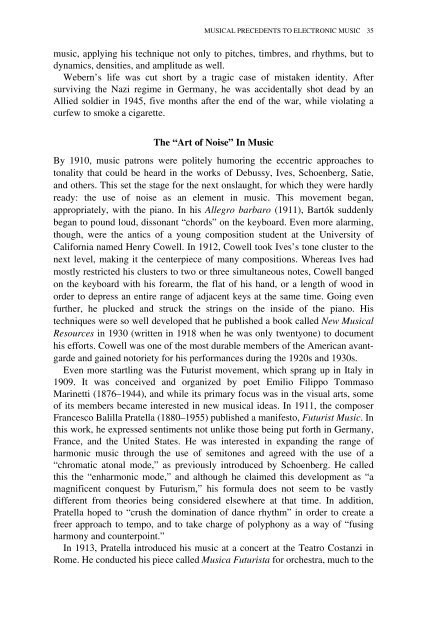Electronic and Experimental Music: Pioneers in ... - Aaaaarg
Electronic and Experimental Music: Pioneers in ... - Aaaaarg
Electronic and Experimental Music: Pioneers in ... - Aaaaarg
You also want an ePaper? Increase the reach of your titles
YUMPU automatically turns print PDFs into web optimized ePapers that Google loves.
MUSICAL PRECEDENTS TO ELECTRONIC MUSIC 35<br />
music, apply<strong>in</strong>g his technique not only to pitches, timbres, <strong>and</strong> rhythms, but to<br />
dynamics, densities, <strong>and</strong> amplitude as well.<br />
Webern’s life was cut short by a tragic case of mistaken identity. After<br />
surviv<strong>in</strong>g the Nazi regime <strong>in</strong> Germany, he was accidentally shot dead by an<br />
Allied soldier <strong>in</strong> 1945, five months after the end of the war, while violat<strong>in</strong>g a<br />
curfew to smoke a cigarette.<br />
The “Art of Noise” In <strong>Music</strong><br />
By 1910, music patrons were politely humor<strong>in</strong>g the eccentric approaches to<br />
tonality that could be heard <strong>in</strong> the works of Debussy, Ives, Schoenberg, Satie,<br />
<strong>and</strong> others. This set the stage for the next onslaught, for which they were hardly<br />
ready: the use of noise as an element <strong>in</strong> music. This movement began,<br />
appropriately, with the piano. In his Allegro barbaro (1911), Bartók suddenly<br />
began to pound loud, dissonant “chords” on the keyboard. Even more alarm<strong>in</strong>g,<br />
though, were the antics of a young composition student at the University of<br />
California named Henry Cowell. In 1912, Cowell took Ives’s tone cluster to the<br />
next level, mak<strong>in</strong>g it the centerpiece of many compositions. Whereas Ives had<br />
mostly restricted his clusters to two or three simultaneous notes, Cowell banged<br />
on the keyboard with his forearm, the flat of his h<strong>and</strong>, or a length of wood <strong>in</strong><br />
order to depress an entire range of adjacent keys at the same time. Go<strong>in</strong>g even<br />
further, he plucked <strong>and</strong> struck the str<strong>in</strong>gs on the <strong>in</strong>side of the piano. His<br />
techniques were so well developed that he published a book called New <strong>Music</strong>al<br />
Resources <strong>in</strong> 1930 (written <strong>in</strong> 1918 when he was only twentyone) to document<br />
his efforts. Cowell was one of the most durable members of the American avantgarde<br />
<strong>and</strong> ga<strong>in</strong>ed notoriety for his performances dur<strong>in</strong>g the 1920s <strong>and</strong> 1930s.<br />
Even more startl<strong>in</strong>g was the Futurist movement, which sprang up <strong>in</strong> Italy <strong>in</strong><br />
1909. It was conceived <strong>and</strong> organized by poet Emilio Filippo Tommaso<br />
Mar<strong>in</strong>etti (1876–1944), <strong>and</strong> while its primary focus was <strong>in</strong> the visual arts, some<br />
of its members became <strong>in</strong>terested <strong>in</strong> new musical ideas. In 1911, the composer<br />
Francesco Balilla Pratella (1880–1955) published a manifesto, Futurist <strong>Music</strong>. In<br />
this work, he expressed sentiments not unlike those be<strong>in</strong>g put forth <strong>in</strong> Germany,<br />
France, <strong>and</strong> the United States. He was <strong>in</strong>terested <strong>in</strong> exp<strong>and</strong><strong>in</strong>g the range of<br />
harmonic music through the use of semitones <strong>and</strong> agreed with the use of a<br />
“chromatic atonal mode,” as previously <strong>in</strong>troduced by Schoenberg. He called<br />
this the “enharmonic mode,” <strong>and</strong> although he claimed this development as “a<br />
magnificent conquest by Futurism,” his formula does not seem to be vastly<br />
different from theories be<strong>in</strong>g considered elsewhere at that time. In addition,<br />
Pratella hoped to “crush the dom<strong>in</strong>ation of dance rhythm” <strong>in</strong> order to create a<br />
freer approach to tempo, <strong>and</strong> to take charge of polyphony as a way of “fus<strong>in</strong>g<br />
harmony <strong>and</strong> counterpo<strong>in</strong>t.”<br />
In 1913, Pratella <strong>in</strong>troduced his music at a concert at the Teatro Costanzi <strong>in</strong><br />
Rome. He conducted his piece called <strong>Music</strong>a Futurista for orchestra, much to the












